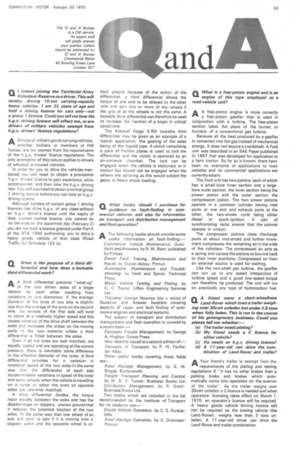What is the purpose of a third differential and how does a lockable third differential work?
Page 55

If you've noticed an error in this article please click here to report it so we can fix it.
AA third differential prevents "wind-upof the two driven axles of a bogie relative to each other resulting from variations in tyre diameters. If the average diameter of the tyres of one axle is slightly less than the average of the tyres on the second axle, the wheels of the first axle will tend to rotate at a relatively higher speed and this causes wind-up of the drive shaft between the axles and increases the stress on the moving parts in the two systems unless a third differential is fitted between the axles.
Even if all the tyres are well matched, are equally loaded and are operating at the correct pressure. there is inevitably some difference in the effective diameter of the tyres. A third differential provides for a variation in rotational speed of the two axles in the same way that the differential of each axle accommodates variations in speed of the inner and outer wheels when the vehicle is travelling on a curve or when the tyres on opposite sides are unevenly matched.
A third differential divides the torque input equally between the axles and has the disadvantage on slippery, uneven ground that it reduces the potential traction of the two axles. In the same way that one wheel of an axle will tend to spin if it is moving over a slippery patch and the opposite wheel is on hard ground because of the action of the differential, a third differential allows the torque of one axle to be relayed to the other axle and spin one or more of the wheels if the grip of all the wheels is not the same. A lockable third differential can therefore be used to increase the traction of a bogie in critical conditions.
The Kirkstall Forge 3-RD lockable third differential may be given as an example of a typical application, the gearing of the axles being of the hypoid type. A clutch comprising a pack of friction plates is used to lock the differential and the clutch is operated by an air-pressure chamber. The lock can be engaged when the vehicle is stationary or in motion but should not be engaged when the wheels are spinning as this would subject the gears to heavy shock loading.














































































































































































































